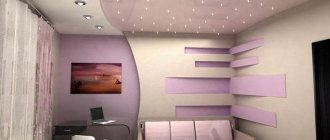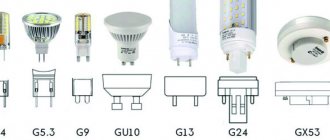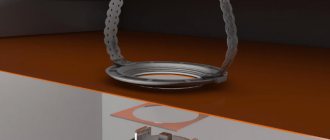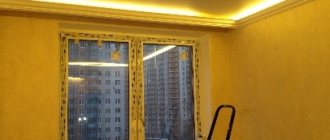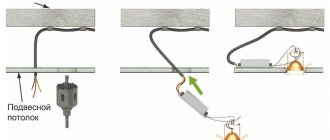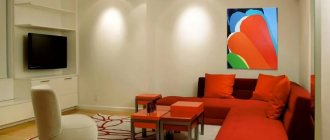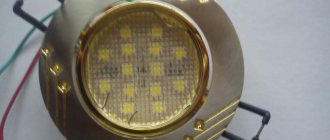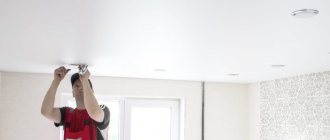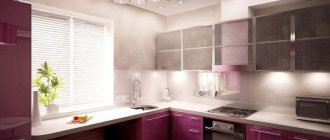11/17/2016 master
Repairing the ceiling is quite a responsible undertaking, which, among other things, involves a wide variety of calculations. Here it is necessary not only to calculate the repair budget, but also to correctly calculate how many lamps, especially if spotlights will be used, will need to be installed. To find out, the first thing you need to do is decide what distance between the lamps should be.
Ceiling lamps
Moreover, such calculations are important not only for creating a general lighting system in the house, but also in production (for example, for security, emergency, etc. types of lighting). Our article will tell you about everything related to this type of calculation.
What lamps are best for suspended ceilings in the bathroom?
Choose fewer lamps - the light will still be bright, and you will save energy. Selection of lamps. LED lamps are best combined with a suspended ceiling - they provide bright light, do not heat up and save energy.
Interesting materials:
How to align only selected text in Word? How to evict neighbors for unsanitary conditions? How to jump high on a block of slime? How high do volleyball players jump? How to post a video on Facebook? How to set boot from disk? How to dry lemon peel? How to dry soap for ASMR? How to dry raw tobacco? How to dry a thick layer of nail polish?
Recommendations for placing lamps
There is no regulation that governs the placement of spotlights in a suspended ceiling. On the one hand, this does not limit your preferences, on the other hand, you can make a number of mistakes and the result will not be the best. General advice is to consider the purpose of the room. If this is a resting place, dim lighting is better; if it is a work area, you need high-quality lighting close to natural.
Posting rules
If you take into account simple recommendations, then choosing the right lighting is not difficult. The main thing is to take your time and think through every little detail so as not to miss a single important aspect. Remember the following:
- When placing luminaires symmetrically, it is worth carefully checking their position to ensure that there is no displacement. If the equipment is positioned crookedly, the appearance of the ceiling and illumination will be disrupted.
Maintain a minimum distance. - It is better to install a separate switch for each zone. If there are a lot of point elements, it is better to think about how to divide them up so that only the part that is needed at a certain moment is included. This will not only reduce electricity consumption, but will also allow you to illuminate only one area.
- If a transformer is included, place it so that it is easily accessible. Most often, it is this element that burns out, so it is worth thinking in advance where to install it so that if necessary, it can be replaced without any problems.
- Select the size of the case according to the characteristics of the ceiling. You need to know exactly the distance from the canvas to the ceiling in order to choose a suitable model so that it does not rest against the ceiling. The minimum distance should be 5 cm.
- The equipment can be arranged in lines, a semicircle, a snake, etc. There are no restrictions, but you need to choose an option in advance and apply marks to ensure that the result will look attractive.
- Use bright lighting for the work area and dim lighting for the rest area. Take into account the presence of other light sources (chandeliers, sconces), as they also give the effect.
You can even combine different types of recessed lights.
Advice! If you need to shift the accents of lighting or adjust the direction of light, it is better to install rotating lamps.
Take into account lighting standards for different rooms. They are installed in accordance with sanitary standards per square meter of area. In the list, the first indicator is for incandescent lamps, the second is for fluorescent options, and the third is for LEDs:
- In the hallway - 10, 6 and 2.5 W.
- For the bathroom - 20-22, 14 and from 5.2 to 5.4.
- In the nursery 60, 36, 6.8.
- For the kitchen 26, 15-16 and 6.8.
- Bedroom - from 12 to 15, from 8 to 10, from 2.7 to 3.4.
- Hall or living room - 20-22, from 13 to 14, 5.2-5.4.
If you follow the standards, it will not be difficult to determine the number of lamps by adding up their total power and dividing by the area of the room.
For the hallway you can only use this option; a chandelier is not needed.
Distance between lamps, basic standards
In order for the room to be well lit and the ceiling to look beautiful, you need to follow several rules for the placement of lamps. Everything is simple here:
- From the wall to the edge of the spotlight there should be at least 20 cm. If you place it closer, then the main part of the light will go to the wall, which can only be useful if you need to highlight a painting, sculpture or something else. It is better to retreat from the wall by 25-30 cm, but in small rooms use the minimum norm.
- The distance between spotlights must be no less than 30 cm. This is the minimum acceptable value, which should be measured from the edge of the body, and not from the center. But it is better to place the equipment every 40-50 cm, this way you can provide good light and at the same time the ceiling will look neat. But you shouldn’t place spotlights at a distance of more than a meter.
- If there are seams on the stretch ceiling fabric, you cannot place the equipment closer than 20 cm from them. This reduces the reliability of the fabric and increases the risk of rupture significantly. If possible, retreat from the seams by 25-30 cm, plan the position of the lamps so that there is no empty space near the joint.
If on the packaging or in the instructions for the lamp there are standards for its installation with distances greater than those specified, you must comply with them. To roughly determine the location, it is worth making a simple diagram with a plan of all the lamps in the room.
Example placement for a square room
Popular layouts for different rooms
The location of spotlights depends on the room in which they are installed, its area and the nature of its use. Each room has its own rules that must be followed. Below are several placement options both without and with a chandelier.
The larger the area of the room, the more options you can choose.
Hallway and corridor
Most often, the room has an elongated shape, a small width, and there is no natural light in it. The exception is corridors and hallways in private houses. It is important to remember the following:
- If the width is more than one and a half meters, it is best to place spotlights around the perimeter. This is enough for normal room lighting. In narrow corridors, it is worth placing equipment in one row in the middle.
- To add light and volume, it is better to use light glossy ceilings and small built-in lamps.
- You can hang mirrors on the walls and place sconces near them to add light.
- Select the area near the mirror, if there is one.
In this case, adjustable options work well. After installation, you can set the light so that the room is illuminated evenly over the entire area.
Illumination around the perimeter makes the corridor lighting spectacular.
Kitchen
It all depends on the size and shape of the room. The larger the area, the wider the possibilities for decoration. There are general guidelines to remember:
- For a small kitchen, you can make spotlights the main source of light. In this case, they should be placed in a checkerboard pattern over the entire surface.
- Medium to large sized rooms usually have a combination of built-ins and a chandelier in the middle.
- Spot lighting is very good for highlighting the dining area. There you can place several lamps and use a separate switch key for them.
- The work area should be illuminated in this way only if there are no wall cabinets in the kitchen.
- It is better to use models with increased moisture protection.
For a small kitchen, spotlights are quite enough.
For your information! Retractable adjustable options are well suited; with their help, it is easy to illuminate exactly the area that is needed.
Living room and hall
In these rooms, the location of the lamps on the ceiling can be anything. It all depends on the size of the room, the arrangement of furniture and the nuances of using a particular area. The features are:
- Usually one or two chandeliers occupy the central place. Built-in elements are used as an additional light source, which has both practical and decorative significance.
- If the ceiling is made in the form of figures or has niches and projections, the position of the spotlights is selected according to their configuration. In this case, you need to remember the distance that should be maintained.
- You can select a separate area if it is used for games or handicrafts. In this case, it is better to use a separate switch button for a group of lamps.
- For decorative use, highlighting certain elements, or illuminating paintings, you can place the equipment close to the wall or even place it in niches.
Arrangement option with diagonal lines.
Any project can be implemented here, especially if the area is large. But we must remember that the more lamps in the ceiling, the more complex the wiring diagram and the higher the installation costs.
Bedroom
People most often relax in this room, so a calm, dim light that is evenly distributed over the entire area is better suited. But there are some features:
- You can highlight the reading area using built-in lights instead of traditional sconces.
- The space around the wardrobe needs to be specially allocated. Here a person gets dressed and evaluates his appearance.
- If the bedroom has a dressing table or desk, this area should be illuminated separately to include bright light if necessary.
In this room, you can install lamps both in the suspended ceiling and in the wardrobe, if it is large. If the area of the room is small, you can actually do without a chandelier.
Stylish ceiling design in the bedroom.
Children's
In this room, pay special attention to the quality of lighting. It should be close to natural daylight so that the child does not strain his eyesight. The rules are:
- Place spotlights as an additional element. It is best to use LED models.
- Designate a gaming area and a work desk so that there is ideal lighting.
- You can install strip lighting around the perimeter so that at night there is a dim light that replaces the night light.
Use safe equipment. If possible, install lamps with at least minimal adjustability in order to fine-tune the light.
Original design of a stretch ceiling in a nursery with built-in lamps.
Thematic video
Bathroom and bathroom
Most often these are small rooms, so they can be fully illuminated by built-in lamps. The basic rules are:
- If the bathroom is tiny, it is enough to place 2 elements in the middle to evenly illuminate the space.
- For the bathroom, select the location of light sources so that the space in front of the mirror is well illuminated.
- Use only moisture-resistant models.
- Choose a layout based on the area and shape of the room. Most often, lamps are placed along the walls, but you can add a few in the middle.
For a small bathroom area, two lamps are enough.
Selecting the correct location of spotlights in a suspended ceiling is not difficult if you use the recommendations from the review and take into account the characteristics of the room. It is worth observing distance standards and taking into account the presence of other lighting equipment.
Common problems and their solutions
The main problem that arises when choosing a layout is the lack of canvas area. The distances between elements become too small, causing sharp spots of light to form. They interfere with the correct perception of the design intent and irritate the visual organs. A ceiling with spotlights should be designed evenly, without excesses or empty areas. The solution to the problem is to use different types of lamps; in addition to point elements, you can add wall or hanging structures. If the distances between devices are too small, their power should be reduced. This will distribute the illumination more evenly and eliminate dark spots.
Important! Rooms that are too large require additional sources. They can be separate groups, or enhance the main lighting line. The main problem that should be solved in such situations is uniformity of distribution, reducing large distances between groups.
Design ideas
A popular design option is the starry sky. The composition is created using miniature light bulbs that imitate twinkling stars or entire constellations in the clear night sky. This method of lighting allows you to create a romantic atmosphere in the room.
Original double models, the light from which can fall on two different objects at once, will organically fit into a modern interior. Certain objects need exactly this distribution of light flux so that it attracts more attention.
Lighting fixtures also come in a variety of shapes. There are products stylized as a square, triangle, circle or hexagon. The design features of the mounting hole depend on the configuration of the light source.
The photo shows a kitchen with a suspended ceiling decorated with double point models.
Models with white matte or black coating are able to organize an interesting light supply. White lighting fixtures on a white ceiling will contribute to the visual expansion of the space and add laconicism to the atmosphere. Black lamps represent a bolder solution that ideally complements an unusual Gothic or strict modern interior.
For a room designed in a classic style, you can also choose suitable products. The lighting market includes devices decorated with a wreath with voluminous crystal petals, models with faceted glass shades, designs with a silver, gilded body or a carved bleached base.
Lamps with a metal frame, decorated with decorative inserts made of colored glass, look very stylish. This way you can achieve an interesting glow, give the interior a special zest and add magic to the atmosphere.
The photo shows spotlights in the ceiling design with an imitation of the starry sky in the living room interior.
Above the dining table
The dining table should be well lit - who would like to look for food on the plate in the dark. Romantic dinners don't count! Hang one or two lamps above the table, depending on the table configuration.
A pendant lamp in the kitchen above a table with a long cord should not hang too low - it will be easy to hit your head. Place one lampshade above the round table - the lower edge of the lamp should be in the range of 70–90 cm
above the tabletop.
The optimal diameter of the chandelier is about half the width of the table. It is better to hang several pendant lamps over a long rectangular table - step back 30 cm
and place them at an equal distance from each other.
Source
How to choose?
To make the right choice, safety requirements must be taken into account.
If there is insufficient ventilation, spotlights can catch fire and damage the ceiling covering. To avoid this situation, it is recommended to install only high-quality models with LED lamps. If you decide to give preference to other light elements, you need to pay attention to their power. Halogen lamps 35-50 Watt or incandescent lamps up to 60 Watt are suitable. It is also important to consider the design, color and material of the lamps, since in addition to the main function, lighting plays a decorative role in the interior. You can diversify the decor of a spacious room and make it more comfortable with unusual overhead spot products.
To decorate a small room, it is advisable to choose small built-in appliances that match the shade of the ceiling. Thus, inconspicuous spot lighting will not affect the surrounding interior in any way.
The photo shows zonal spot lighting in the interior of the kitchen combined with the living room.
Organization of the work area
Lighting the work area
The work space should be understood as the food preparation area. If most housewives have a headset, this process is carried out on the countertop. But in each specific option, the location of local illumination is selected individually. Since not the entire tabletop is used during cooking, it is much more profitable to illuminate only a certain area or section the lighting devices to separate them into sections.
This type of lighting in the kitchen can be implemented with both conventional lamps and LED strips; the choice of model is made based on the parameters of the room and your wishes. The main requirement is that the light flux should fall directly in the center of the tabletop, and furniture and other structures should not limit its spread.
You can place devices to illuminate the work area:
- under wall cabinets - along the line of the apron, in such a situation the light flux is directed at an angle, for this you can use both pendant lamps on hinges and LED strips in a special box or without one;
- above them - in suspended ceilings; for this purpose, soffits are mounted in plasterboard;
- flush - provided by any suitable type of lighting fixture, which is placed on hanging cabinets.
The last two options should take into account the depth of the upper and lower cabinets. The principle of their installation is shown in the figure below.
Working area lighting principle
The stove or hob is usually illuminated by lamps built into the hood. But if they are not enough, additional devices that are resistant to high temperature and humidity can be installed.
Optimal solutions
Stretch fabric has great decorative potential, which is realized with the help of lamps. There are many ideas for placing ceiling lighting fixtures. They are based on the uniformity of lighting, but take into account the features of the interior or the shape of the room. If there are decorative plasterboard structures, then the placement of lamps follows their shape, decorating and emphasizing the design elements.
Spot devices are installed around the perimeter of the room, or grouped in the center. In the latter case, the distance between them may be significantly less than the recommended values, but the overall brightness is compensated by a decrease in the power of individual point elements. A method of decorating a canvas that imitates a starry sky is often used, when the entire surface is filled in a chaotic manner with small lamps.
Important! It is most convenient to design a square ceiling, which allows you to create strict geometric groups. It is more difficult to choose a style in long and narrow rooms, when the distance between the long walls is small and greatly limits design possibilities. In such situations, additional elements installed on walls or other surfaces are used, and the ceiling slab is left free.
Before starting work, you should carefully consider and draw up a diagram of the location of point devices with the obligatory indication of the distances between them. This will help you find them after installing the tension fabric.
Light sources for illumination
When choosing the location of lamps on the ceiling, you need to take into account all light sources. And the backlight too. At least she plays, mostly. decorative role, but also makes its contribution to the illumination.
For illumination, linear lamps are often used. They come in luminescent and neon colors. LED linear lamps or LED strips are also used. The best option in this case is LEDs in any design. They have several advantages. The first is that they are more economical (they consume 3-4 times less electricity than “housekeepers”), the second is more durable (although subject to temperature conditions), the third is that they heat up much less than the others. They also have disadvantages: they require a reduced voltage (24 V or 12 V) for power supply, and therefore require converters. They also cost money, they need to be placed somewhere, and so that they are accessible for routine maintenance and repair. And another minus is the high price. But if you consider that their working life amounts to thousands of hours, then it turns out inexpensive.
Neon lighting looks good
If for some reason LEDs do not suit you, you will have to choose between fluorescent and neon lamps. Usually they choose fluorescent ones, since installation and connection are simple and can be done with your own hands without the involvement of a specialist. Disadvantages: flickering light and “cold” glow.
Neon lamps look good when illuminated, but installing them is a hassle and not so easy to figure out. That’s why they either invite specialists or choose some other light sources.
Recommendations for choosing lamps
Taking into account a few simple tips, choosing a lamp is not difficult. If you know the placement of points and the arrangement of furniture in the room, there will be no problems with calculating power. But there are a number of other criteria that should not be forgotten:
- Degree of moisture protection. For a bathroom, toilet or kitchen, it is better to choose models with increased protection against moisture, which are marked IP44.
- Type of light bulb used. It is better not to buy options with a traditional incandescent lamp, as they get very hot, which is undesirable for a stretch ceiling. Fluorescent and halogen ones are also not the best choice. The ideal solution is LEDs; they consume little energy and do not heat up much during operation.
- Appearance. The spotlight should be combined with the light of the ceiling and fit into the interior.
- If you need to shift the emphasis of lighting, it is better to choose rotating options.
Advice! Do not buy the cheapest models; their quality usually leaves much to be desired and their service life is short.
A spotlight is a full-fledged element of interior design.
When choosing lamps, consider the type of socket and the ease of replacing the lamp; the easier it is, the better. Options with LEDs come without lamps; in this case, if they fail, you will have to buy new ones or disassemble and resolder the diodes, which is not very easy.
Where to hang a chandelier in the kitchen?
Minimum list of necessary light sources for the kitchen:
- general lighting
- above the working surface of the table top
- above the hob
- over the sink
- over the peninsula island
- above the dining table
- architectural lighting / for art / for mirrors
Interesting materials:
How long to take thyroxine? How long does Sample B remain frozen in the laboratory after Sample A is analyzed? How long does it take for swelling to go away after a bee sting? How long does it take for lawn seeds to germinate? How long does wallpaper primer take to dry? How long do chrysanthemums bloom? How long should honey mushrooms be cooked before freezing? How long does it take to recover from a torn ligament? How long to wait for a passport through government services? How should the TV be positioned?
